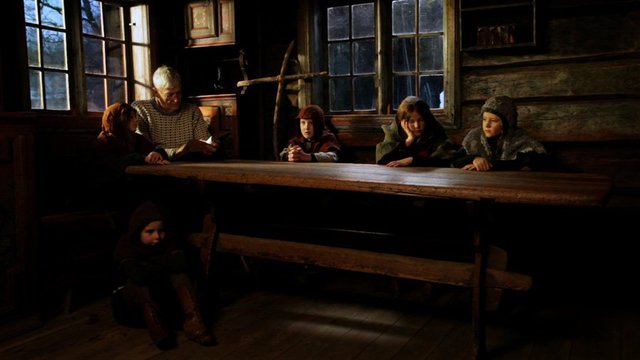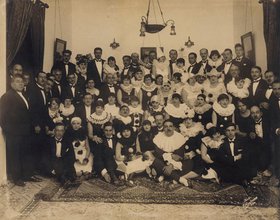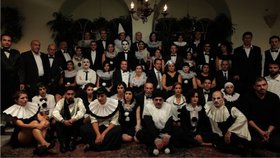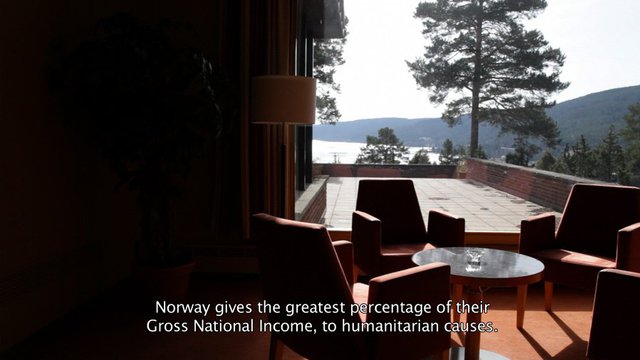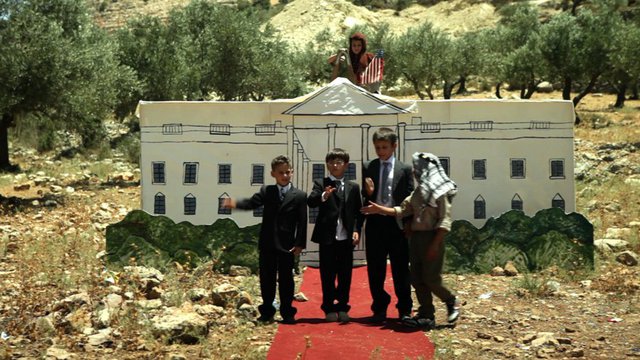Interviews
Expanding the Archive
Jumana Manna in conversation with Sheyma Buali
For the most part, knowledge is fragmented and knowledge of history even more so. Often histories are simplified, placed within vacuums of loosely-defined regional and nation-state borders where nuances are overlooked. Artist Jumana Manna counters this by allowing her audience a window where histories become cross-continental networks, exposing the sometime-unsettled subtleties of relationships. In the past, Manna has opened the doors to more human intimacies between athletes and their coaches in the case of Umpire Whispers (2010). Meanwhile, Blessed, Blessed Oblivion (2010) visits the masculine spaces of garages and barbershops, depicting how the male response to the pressures of living under occupation in east Jerusalem manifests into vulgarity, misogyny and muddled desires of heroic resistance and petty crime.
Manna's two latest projects look at political histories with a similar lens. The Goodness Regime (2011-2013) is a collaboration with artist Sille Storihle. The film explores, with the help of a cast of children, the foundations of the ideology and self-image of modern Norway – from the Crusades, via the adventures of Fridtjof Nansen and the trauma of wartime occupation, to the diplomatic theatre of the Oslo Peace Accords. A Sketch of Manners (Alfred Roch's Last Masquerade) (2012-2013) re-imagines a decadent evening at the home of the flamboyant politician in the years leading up to the Nakba of 1948.
In this interview, Sheyma Buali speaks to Manna about her latest projects, discussing the importance of cracking otherwise accepted narratives of the past and opening up less explored avenues of history.
Sheyma Buali: What is it about incorporating archival material into your work that interests you? Why do you find it important to revive certain histories?
Jumana Manna: I'd say the desire for an archaeological approach comes from realizing that the conditions I (we) live and work under are not those we created, but those created by our historical circumstances. This is the case everywhere but for those nations or minorities whose history and culture is under threat of erasure, the need to assert ones presence is not an uncommon one. One of the ways of doing that is by addressing history. Otherwise, it is left up to hegemonic narratives that tend to exclude a more nuanced understanding of the past and its impact on our present. There is a strength in knowing more about the past, awakening forgotten pockets that expand perspectives and allow for a suffocating city, like Jerusalem, to stop gasping for a moment.
Some weeks ago, a friend mentioned this old metaphor to me: 'If I have seen further, it is by standing on the shoulders of giants.' That is to say, our discoveries and creations are built on those that came before us. I liked this image, because it acknowledges that I exist because my family and their greater community happen to exist, and there is a certain character that comes with that. I feel in turn, that the old also stand on the shoulders of the young. They can be heavy and demanding and other times humorous and inspiring. The basic need of rooting oneself and one's cultural production to the awareness of the discoveries and faults of previous generations remains a necessary one for me.
If we were to choose to be born into whichever nations we wanted, or even choose our ancestry, that would be something else. Imagine us curating our own family albums. Would we feel free from history then?
As for incorporating archival materials, 'archives' in the classical sense of a record office, is just one source amongst the memoirs, oral histories, musical recordings, and novels that I think of as archival material. I like to refer to archive in this expanded sense.
SB: Imagination has a very important role in your films, particularly A Sketch of Manners (Alfred Roch's Last Masquerade), in which you construct the story based on what has happened since the photo was taken. But at the same time, the film is not entirely fiction in that you are imagining the historic realities more than fabricating them. Can you talk about the photo the film is based on, who the Alfred Roch of the title is, and how imagination became important in your historical narrative?
JM: A Sketch of Manners is an interpretation of an archival image where the facts have been shuffled and the story behind the image partially interpreted. The archival image that sparked the film is of a group of Palestinians dressed as pierrots, posing for a photograph. I was so drawn to this image when I saw it; it was so enigmatic and carried a sense of self-irony. I couldn't really place it in the depictions of urban life from the period. Who was this stylish crowd, and why did they chose to dress as pierrots? I gathered all the information I could find and tried to imagine the conditions of their lives as a way of getting in touch with this peculiar aspect of Palestinian history – one that is pre-crisis, before the narration of the Nakba of 1948. One that we know little of.
I learned that the photograph was taken in 1924 at Alfred Roch's house, at one of his annual masquerade parties. Roch was a rich man, a landowner, and a representative of the Greek Catholic community in Jaffa. In 1928 he was elected to the Palestinian National Congress, and was later a member of the Palestinian Delegation to London at St. James Palace in 1939. Roch was quite an original figure; he lived a bon vivant lifestyle while simultaneously struggling against the partitioning of Palestine. He subverts the image of what the 'Palestinian politician' is.
Despite the fabrication of the details of the story in A Sketch of Manners, I tried to remain true to the spirit of the moment, so there are enough historical elements to claim this could have happened, without the film actually claiming narrative truth. I wanted to distort the linearity of time so that I could relate to the Nakba of 1948 not as an ossified moment in the past, but rather as an ongoing event or structure.
I decided to set A Sketch of Manners in 1942, at the height of World War Two in Europe. The characters, my friends and family from Jerusalem, Jaffa, Ramallah, Haifa, Nazareth, Majd al-Kurum and other villages in the Galilee, are playing themselves as much as they are stepping into the characters from the photograph. There is an overlapping of positions, like when you adjust the opacities of two juxtaposed images placed on top of each other: the two positions momentarily coincide to create a third.
Going back to the importance of imagination, maybe foregrounding imagination over truth is a form of storytelling that goes beyond the need to resolve competing narratives. It's a way of focusing on how things are remembered, and how that forms our understanding of ourselves. The challenge remains how to suspend narrative, or rather, narrative resolution, without simply resulting in a kind of amnesia – that same amnesia that one started out wanting to resist.
SB: You have a recurring strength, which is that you bring out layers and connections that are not as exposed or discussed, in history as well as in relationships. You do this in The Goodness Regime, which was a collaborative effort with Sille Storihle, and your own project A Sketch of Manners, but also in your previous works, such as The Umpire Whispers (2010), in which you talk about the intimacy between a coach and an athlete. What are you seeking when you are looking for material to work with?
JM: The Goodness Regime and A Sketch of Manners are quite different in terms of the motivation behind them, as was The Umpire Whispers. For A Sketch of Manners, I was searching for moments that excite and attract me, that provide an alternative imagination to Jerusalem, or Palestinian cities in general. I am often drawn to controversial, politically dubious or maverick-like characters. This may be a cliché, but they do provide a more raw and accurate image of the moment than self-righteous narratives that want to preserve honour and pride. It is in the cracks and sidelines that the most humorous and sympathetic stories are found.
SB: What is it within these cracks that you want to unravel?
JM: In A Sketch of Manners, as for my older works Blessed Blessed Oblivion and The Umpire Whispers, which are also filmed in Jerusalem, I wanted to bring attention to the multi-faceted social fabric of Jerusalem, and the particular kind of dark humour in the city. There is a certain mendacity in Jerusalem, as well as a certain quality of neglect, that is in contrast to the imaginary of the city as a holy, serene, ancient promised land. Religious travellers who have come here for centuries write travel logs about their experience of arriving in Jerusalem, and their subsequent disappointment at the normalcy of the 'holy city'. Their fantastical projections are deflated when they arrive and see the poverty, the cynical businessmen selling identical souvenirs, and just the banality of daily life. I like to think that the projections of the various imaginaries of Jerusalem insert a subliminal spiritual layer in the city that you have to make an effort to tune into. It is precisely that foggy area between the melancholic mendacity and the religious fantasy of Jerusalem that I would like to capture. The frivolous characters I choose to focus on bring a perverted image of the holy city through their obsessions with artificiality, games and lies.
SB: In your director's statement for A Sketch of Manners, you noted an interest in the 'bifurcated relationships between Palestine and the West'. How do you position these two 'parts' ('Palestine' and 'the West') when you are constructing the questions that you explore in your research and eventual films?
JM: I started working comparatively almost by accident. I suppose that is a result of my increasing number of homes: I was raised in Jerusalem and had my extended family in the Galilee. I studied and lived in Oslo for some years. I was born in the USA but had never really lived there before moving to Los Angeles to do an MA at CalArts. Now I'm in Kreuzberg, Berlin, which is closer to the Ottoman Middle East in certain ways than anywhere else today.
Palestine (and the Levant in general) has always been very close to Europe. Europeans have ingrained the Bible land intimately in their imaginaries. The common claim about the Arab Renaissance is that it was sparked by Napoleon's arrival in Egypt in 1798. Islam has had a longer history than Christianity in parts of Europe, in Andalusia and elsewhere across the Mediterranean. So the Arabs have had a love/hate relationship with Europe since the seventh century. But arguably, the division of the west and Middle East is stronger today than it was further back in time.
In A Sketch of Manners, what I was interested in was the bifurcated relationship of Palestine to the British Empire during early Palestinian nationalism. I was especially interested in the politics of the notables, who occupied a certain political role as intermediaries between the British, and – within certain limits – the leaders of the Palestinian population. The Palestinians in general, and the elite in particular, allied themselves with Europe, particularly Britain and France, to get rid of the Ottomans during the First World War. Even when they discovered the colonialist side of the European empires, they continued seeing them as a model for modernity.
I was intrigued by how the British, and then later the Jews, were both seen as an enemy, as occupiers, and yet also as a model of modernity and national awakening – a kind of violent relationship. It is not difficult today to see many Palestinians in Israel who have a similar bifurcated relationship towards the Jews and Israel.
SB: I find it really interesting that you connect local histories internationally, looking at things from a wider perspective. The Goodness Regime looks into Norway's history and culture, their experience and reaction to the Second World War, and draws it back to how that has affected you and the development of your country. On one hand one can say that Palestine, like other Middle Eastern countries, is not the keeper of its own history. But on the other hand, this is an example of what the Middle East's so-called 'postcolonial' state really is, one that is still lead by outside forces. There is something that you said in an interview with Kate Sutton in Bidoun (#27)[1] that I found very interesting. You say: 'I've been thinking about how you can deal with politics without just looking at the Other.' Can you expand on that?
JM: Firstly, The Goodness Regime has been different in process than other projects because it is a collaboration with Sille Storihle. It grew out of our conversations when we met in Los Angeles doing our MA in Aesthetics & Politics at CalArts. We had both moved to California from Norway. We were experiencing a rhetoric and discourse in the American classroom that was so different from that of Norway; it used a more direct and bold language, and was obsessed with identity politics. In Norway, politics are harder to grasp. They are subtler and identity politics is almost treated with hostility. We wondered where this undercurrent of discomfort with politics came from, especially in the art scene in Oslo. The Scandinavian cultural code known as janteloven (The Law of Jante) says 'don't think you are anything special, nor that you are better than anyone else' and 'don't act as though you are better than anyone else. Don't stand out too much in the crowd.' It encourages a culture of consensus, not difference. This unspoken law was central to the attitude we wanted to critique.
We wanted to better understand the foundations of modern ideology and self-image in Norway, and how to deal with it through moving image. We chose the Oslo Accords as the starting point, as a shared moment of the places we come from, Norway and Palestine/Israel, and as a rather ironic transnational moment that had a different impact on the various players. Our key questions were: What role did Norway play in the accords? What relevance did this role have to Norway's position globally, and it's politics internally? And how did Norway come to have such a resilient self-image of benevolence and peace? Key for us was the contradiction of the Oslo Accords on the one hand, being a shining moment in Norway's diplomatic history, and, on the other hand, a capitulation of the Palestinian revolution, bureaucratizing the occupation and introducing a whole new package of disasters and obstacles to the 'Palestinian Question'. We wanted to come closer to understanding the complexities of this contradiction, and the moral dilemmas of intervention and its responsibilities, without assuming that the failure was to be blamed on a cynical manipulation by Norway. We were curious about how the politics and imaginaries of three different national identities operate when juxtaposed against each other.
The works of Nina Witoszek , who wrote The Origins of the Regime of Goodness and Terje Tvedt, both Norwegian critics looking at Norway's politics and cultural history, were very helpful for us. Tvedt coined the term, 'the regime of goodness' in his book, Foreign Aid, Foreign Policy and Power: The Norwegian model. According to him, it is a virtual state within a state which comprises over 200 voluntary organizations, over 3,000 international aid workers, and a wide range of research institutions, all on a payroll of the state, which both exercise and legitimize Norwegian foreign aid politics in developing countries.
For Witoszek, 'the regime of goodness' is a deeply felt tradition based on the imperative of goodness, which exerts a gentle blackmail on the national soul. The tradition was codified by Enlightenment priests and then reinforced by the architects of national identity – all of whom flaunted goodness as the basis of national identity.
So this regime is both a performance, and an abstraction, which uses the world as a narcissistic mirror for Norway. This mirror also points to the position of Palestine as the 'ace card' of global politics, which most countries want a hand in because it services their positioning in the world. In this light, Norway is not different from other countries
SB: Can you tell me about your's and Sille's choice to cast children?
JM: We tried to condense and translate these concepts through the allegorical enactments of children, and by abstracting the politics in the film as archetypes. We sift through the official pedagogy of history, one that prefers a narrative of confidence than complexity. Simplified, The Goodness Regime tells a story of the young nation of Norway, freed from its union with Sweden at the turn of the century. It prides its explorers, such as The Nobel Peace Prize winner Fridtjof Nansen, who reaches the North Pole and assists Armenian refugees in the 1920s. Thereafter Norway resists the Nazi Regime between 1940–45. Two decades later, large quantities of oil and gas are miraculously found, which help build a strong and stable social welfare. With this economy, and the end of the Cold War, the Norwegian Model of Peace and Reconciliation is constructed. Building on a long tradition of good intentions, this model becomes central to Norway's foreign policy.
We chose the protagonists of our film to be children dressed as crusaders or missionaries who travel to an imaginary holy land. It could allude to the children's crusade of 1212, or a protestant enlightenment ethic embodied in missionary work. For us, it was also an allegory of the small, harmless nation coming to help after all other attempts failed. Our protagonists return home to a small wooden house, uncertain about their achievements, after discovering that implementing these ideals does not always bring the desired results.
SB: What is your research process like? I know that at times it may be more deliberate, such as what you and Sille did with The Goodness Regime. You have noted reference to a few texts about the relationships between Norway and Israel by Hilde Henriksen Waage and your incorporation of particular imagery to construct your views, like the use of the national-romantic painting of Adolph Tidemand and the locations where meetings took place, along with photos and sound recordings. These are very particular documents that you and Sille used to string together your exploration. But for Sketch of Manners, the entire film is sparked more serendipitously by a found image, which inspired a set of questions that lead to your well-developed 'reverie', so to speak.
JM: In the case of The Goodness Regime, the process began through the discussions with Sille, as I mentioned earlier. The process involved reading and interviewing historians, sociologists, journalists, aid workers and politicians in Norway, Israel and Palestine. We met with some of the individuals who were involved in the secret 'back channel' that lead to the signing of the accords. We spent many hours in the national library in Oslo listening to audio recordings, watching TV reports, looking at paintings in museums and in the Oslo City Hall, and discussing the links between rhetoric and imaginary of the nation that we recognized.
Quite early on in our research, we read an article by Hilde Henriksen Waage called 'The Secret Missing Papers', which focuses on the 'back channel' negotiations that took place in Norway. Waage was hired by the foreign ministry to write a report on Norway's third-party mediation role. She discovered that all the documents from the eight-month back channel were missing from the National Archives. The individuals, most importantly Terje Rød-Larsen, did not deliver their notes and letters, with the claim that these were personal documents. This dubious matter lead Waage to trace back the role of Norway in the Middle East, from the post-war period until today, shedding a new light on the Norwegian actor's differing relations with the two sides, and the limits of a small-state negotiating party. She concluded that a peace process marked by a fundamental asymmetry of power was met by limitations and drawbacks, with the third party being a weak intermediary. Waage was attacked both by the ministry and the press for her insights and criticisms.
We were quite shocked by the attacks that Waage received as a result of her report, and it made us question about the state of self-criticism in Norway. How can it be that, despite the controversies of the accords and the disaster they brought about in Palestine, Norway continues to engage itself in numerous peace exports around the world? How has Norway's image of benevolence remained so resilient to critique?
Once we grew more confident with the material and our position, it became much easier to imagine the project formally. Still, the process was cumulative, with a lot of learning as we went along. We shot and edited various scenes over a course of one and a half years.
A Sketch of Manners happened more suddenly. I was looking into pre-1948 leisure and upper class 'bohemia' circles for a broader project called Imagined Cities, when I learnt about Alfred Roch and his masquerades. The research here was similar in terms of literature and interviews, but also involved lots of wandering in Palestinian cities, Jerusalem most of all, and stumbling upon sites I hadn't reached or paid much attention to in my childhood. One of them was this stalactite and stalagmite cave, which appears at the end of the film as a kind of hidden world. I remember visiting this cave in Middle School in one of our 'Jerusalem Studies' trips. I was intrigued, but more concerned with the blonde boy in class who wasn't giving me the attention I wished for. So I went back with my camera fifteen years later to look again.
The potential of this singular image of the pierrots was the most exciting and urgent of the materials I was gathering, and it all happened very fast from there – first as a party event/performance framed as a film set in the American Colony Hotel's 'Pasha's Room' in Jerusalem. Then, figuring out how to edit this into a film, and write a voice over to suit the narrative. The set was improvised, with lots of good will from friends. The secret of its success, as an event at least, was because people responded so positively towards the image I invited them to 're-live'.
SB: This broader project Imagined Cities, of which A Sketch of Manners is a part, has to do with the notion of 'farce' (theatrics and artificiality) in two cities, Jerusalem and Los Angeles. Can you tell us more about this?
JM: Imagined Cities began from the desire to bring a counter-narrative of two over-mystified cities, 'promised lands' of opposite sorts: Jerusalem and Los Angeles. The intention was to link forgotten histories from these two iconic yet contrasting cities where I have lived, but also to reflect upon what these cities signify to the human soul that has made them so attractive to the imaginary of much of the world. In 2012, I began researching and writing with cultural historian Norman M. Klein. Norman's most famous book, History of Forgetting: Los Angeles and the Erasure of Memory, sparked some of the ideas for Imagined Cities. He was also one of my two readers for my MA thesis, which was on the question of positioning in Godard's Here and Elsewhere, a self-critique on the anti-imperialist fantasy that dictated his unfinished militant film about the PLO with Jean-Pierre Gorin. Some of our ideas naturally grew out of our conversations on that too.
We've written a blueprint for a film. It tells the story of a musician, a drifter, who keeps falling into situations of mistaken identity. In 1948, many from his community are exiled from Jerusalem, and this tragic new reality triggers a moral and political crisis. This leads him to do the previously unimaginable: he moves to Echo Park, Los Angeles. Like so many people who see LA in their mind's eye, he fancies a future in the movie industry. What he finds is an episodic carnival of misunderstandings.
View stills from The Goodness Regime, presented in Ibraaz's project space, here.
Jumana Manna (b. 1987, USA) works primarily with film and sculpture. Her work often addresses issues of the body, nationalism, and history. She holds a BFA from the National Academy of the Arts, Oslo and an MA in Aesthetics and Politics from California Institute of the Arts. Recent exhibitions and screenings include Performa13 Biennial (New York City), Home Works Forum VI (Beirut), Kunsthall Oslo (Oslo), Berlinische Galerie (Berlin) and ICA (London). In 2012, she was awarded The Young Palestinian Artist of the Year Award from the A. M. Qattan Foundation.

